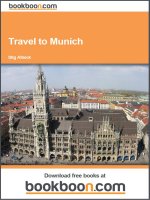Travel to Shanghai pptx
Bạn đang xem bản rút gọn của tài liệu. Xem và tải ngay bản đầy đủ của tài liệu tại đây (3.91 MB, 43 trang )
Download free ebooks at bookboon.com
Download free ebooks at bookboon.com
Shanghai
© 2008 Stig Albeck & Ventus Publishing ApS
Translation: Liz Bramsen
All rights and copyright relating to the content of this
book are the property of Ventus Publishing ApS, and/or its
suppliers. Content from ths book, may not be reproduced
in any shape or form without prior written permission from
Ventus Publishing ApS.
Quoting this book is allowed when clear references are made,
in relation to reviews are allowed.
ISBN 978-87-7061-280-7
1st edition
Pictures and illustrations in this book are reproduced according
to agreement with the following copyright owners
Stig Albeck, Gorm Albeck, Tony Hansen & Suzhou City
Tourism.
The stated prices and opening hours are indicative and may
have been subject to change after this book was published.
Download free ebooks at bookboon.com
Shanghai
4
Kapiteloverskrift ONLIBRI
Download free ebooks at bookboon.com
Shanghai
5
A Visit to Shanghai/Ϟ⍋
www.cnto.org
Shanghai has great historic attraction. It is one of the
largest Chinese cities; a lively and interesting
metropolis. Shanghai is one of China’s economic
locomotives, something that shows quite clearly in
the city streets, which function as a showcase to the
world of Chinese progress and increasing wealth
within the global economy. For tourists, this means a
number of fascinating skyscrapers and exciting
modern architecture, not least along the city’s harbor
where the Pudong district rises up impressively
opposite the old city center.
Shanghai is not just modern glass and steel – on the
contrary – it houses buildings and cultural
influences from both ancient China and from the
colonial powers that have traded here. On the Bund,
a street along the waterfront, we find some of Asia’s
most well-known buildings in European style, for
example the Peace Hotel, a structure that oozes
1900s Shanghai atmosphere.
In the streets, one also finds Chinese temples, thus
completing the varied impression of new and old
elements from different cultures. And if you fly in
via Shanghai’s airport, you can look forward to it all
on the short ride to the center on a train that
reaches speeds of more than 400 kilometers per
hour – a meeting with modern China right from the
start.
Have a good trip!
A Visit to Shanghai
Download free ebooks at bookboon.com
Shanghai
6
Historical outline
Shanghai’s history goes way back. The area was part
of the Songjiang province, ruled from nearby
Suzhou, before it became a real town. Under the
Song dynasty (960-1279) the area began to develop
into a small town. Its main function then was as a
port.
The year 1553 is regarded as the beginning of
Shanghai’s existence as a proper town. This was
when the town walls were built, creating a structure
in the scattered dwellings. The town continued to
play an important role as a harbor, but it was not
until the 1800s that more extensive development
took place. In spite of Shanghai’s present size, it is a
relatively young city and there are not as many old,
traditional Chinese buildings as in, for example,
Beijing or Nanjing.
In the 1800s, Shanghai’s significance to trade grew
due to its good position close to the mouth of the
Yangtze River. This made it especially attractive to
Western countries, which were otherwise denied
access to the closed Chinese harbors.
The first Opium War ended with the signing of the
Nanjing Treaty in 1842. China had to hand Hong
Kong over to the British and to open some of its
harbors to Western traders –including the harbor in
Shanghai, which was the most interesting one of
them all. Further agreements in the following years
expanded the foreign rights in the city and the
harbor.
The national Taiping rebellion began in 1859 and
continued until 1864. It became one of the bloodiest
periods in Chinese history – defeats to foreign
powers and natural catastrophes occurred repeatedly,
and in the opinion of the rebels, without the proper
sort of reaction from the Manchurian Qing dynasty.
The areas of Shanghai under foreign domination
were kept out of the conflict and became a goal for
refugees fleeing from the many battles that took
place in China.
After battles in the Shanghai area in 1853, a city
government was established in 1854. The intention
was that the foreign areas should have a
coordinated leadership, not least due to the
increasing numbers of Chinese newcomers.
During the war against Japan in 1894-1895, China
had to give up Formosa – now known as Taiwan –
and Japan became one more nation ruling over part
of Shanghai, just like England, France, Russia, and
the USA.
The Japanese were the first to start factories in the
city and soon the other foreign powers began to do
the same. This became the beginning of the great
industrialization of Shanghai, which, in time, made
it the absolute economic center of power in the
nation. This status was based on more than just the
large harbor and the financial sector – which was
the largest and most developed in the Far East.
Shanghai’s great importance to China began to
demand that special measures be taken with regard
to the political organization of the city. Until 1927,
Shanghai was part of the Jiangsu province, whose
capital was Nanjing, but now Shanghai was made
into a special administrative zone on the same level
as one of China’s provinces. In 1930, Shanghai
formally became a county and a province on its
own, and this provided possibilities for an even
better structuring and planning of the future of the
city.
In the beginning of the 1930s, the Chinese in
Shanghai began to feel a growing desire for
independence in this partly foreign city. Japan
bombed the city in 1932 and after scattered battles
and rebellions, the city was conquered by Japan in
1937. The Japanese occupation lasted until 1945.
Historical outline
Download free ebooks at bookboon.com
Please click the advert
Shanghai
7
During World War II, Shanghai became a refuge for
Jews, among others. The city’s historical role as a
very international and tolerant city continued.
In May of 1949, The Chinese Communist Party took
power in the city and as a result, many foreign
businesses and trade offices moved away, choosing
British Hong Kong as the seat of their activities in
the Far East instead.
From the 1950s to the 1960s, Shanghai experienced
a great new industrial period of growth. In the times
of the People’s Republic of China, Shanghai has
always been the center of production and trade. The
new economic boom in China, which started in the
1980s in the Guangdong province, put Shanghai on
the map once and for all as one of the economic
giants of Asia.
The development really gathered speed after 1991,
when new initiatives aimed at attracting both
Chinese and foreign investments were implemented.
The leader of the People’s Republic, Jiang Zemin,
had once been mayor of Shanghai, and he took the
lead in establishing the new, impressive city one
sees today.
Historical outline
Download free ebooks at bookboon.com
Shanghai
8
Tour 1: Shanghai
1. The Old Town District/Nanshi/फᏖ
Nanshi
Metro: Huangpi Lu
For a long time, Shanghai consisted of separate
districts, most of them governed by foreign nations.
The Chinese district was under Chinese rule until
1949, and thus it was here that one could find a truly
Chinese atmosphere. Today, one can still experience
some of the narrow, densely built streets that give an
impression of the Shanghai of the past. The district
lies within the area bordered by the two streets,
Zhonghua and Renmin, which were both
constructed upon the area of the filled-in moats.
2. The City God Temple/
Chenghuang Miao/ජ䱡ᑭ
Anren Lu 218
Metro: Huangpi Lu
The City God Temple is in Shanghai’s old town
district and together with the fantastically beautiful
Yuyuan Garden/⽖࿌, it presents a fine example of
a classical Chinese garden and temple complex.
The garden was laid out in the 1500s during the
Ming dynasty. It includes all the elements of a
garden of the time – artificial hills, rocks, carp
ponds, dragon paintings, zigzagging bridges, and
pavilions. In modern Shanghai, it is like entering
another world.
Around Yuyuan garden, a market area of great
interest for tourists has been built. There are
various shops here, and in the middle of the small
pond of the area, you will find the Huxingting tea-
house, which is the oldest one in Shanghai.
3. The Bund/Wai Tan/☬
Zhongshan Dong Lu
Metro: Henan Zhong Lu
The Bund is a street area unique to all of Southeast
Asia. Along its 1.5 kilometers there are 52 buildings
constructed in various styles: Gothic, Renaissance,
Baroque, neo-classical and art deco. Thus, it is easy
to understand why the Bund is also called an
international museum of architecture.
The Bund’s history started as an English building
project and at the end of the 1800s and the
beginning of the 1900s, the great boom in the
Tour 1: Shanghai
Download free ebooks at bookboon.com
Shanghai
9
economy and the construction business made the
area an important financial center in East Asia.
The many houses consisted mainly of trade houses
and banks from many nations: England, France,
Russia, Germany, Japan, and the US. Both a Russian
and an English consulate were also placed here.
The buildings came to have new functions once the
People’s Republic of China was established in 1949.
Today, the Bund is visited extensively, both during
the day and the evening. Along the river, there is a
lovely promenade from which there is a view of the
many interesting houses and of the modern Pudong
district on the opposite bank. It is also a good place
from which to follow the intense and varied ship
traffic. In the evening, there are many activities here
and the buildings on both banks of the river are
brightly illuminated.
The Monument to the People’s Heroes/Renmin
Yingxiong Jinianbei stands at the northern end of
The Bund, and close to this is The Bund Historical
Museum/Waitan Lishi Bowuguan.
3a. The Peace Hotel/Heping Fandian/
ᑇ佁ᑫ
Nanjing Lu 20
www.shanghaipeacehotel.com
The Peace Hotel was built by Victor Sassoon in 1929
as Shanghai’s most glamorous hotel – at that time it
was called the Cathay Hotel. The hotel came into
Chinese hands in 1949 and reopened as a hotel in
1956. The hotel is known for good jazz music and a
1920s-1930s atmosphere. From the roof terrace,
there is a choice view over the area and especially of
Pudong.
Today, the Peace Hotel consists of two buildings.
The northernmost one is the original Cathay Hotel,
but the southern one stems from 1906 and stands
where the Palace Hotel originally stood.
3b. The Customs House/Haiguan Dalou/
⍋䮰
ῧ
Zhongshan Dong Lu 13
The Customs House on the Bund was built in 1927
as a replacement for an older Customs House in
Chinese style. Its clock tower makes it the Bund’s
most characteristic structure. The clock tower is
called Big Ching and is inspired by Big Ben.
3c. Hong Kong & Shanghai Bank/Huifeng
Yinhang/
ः䈤䡔㸠
Zhongshan Dong Lu 12
The bank building with the large dome beside the
Customs House was built in 1923 and now houses
the Hong Kong & Shanghai Bank. The interior of
the building is worth seeing, and in its own day, it
was said to be the most luxurious building from the
Suez Canal to the Bering Strait.
Tour 1: Shanghai
Download free ebooks at bookboon.com
Please click the advert
Shanghai
10
4. Boat trip in Shanghai’s harbor/
咘⌺∳䘞㽻
Zhongshan Dong Lu
Metro: Henan Zhong Lu
Along the Bund from Jinling Lu Street, one can
take a boat trip on the Huangpu River and the
smaller Wusong north of the Bund. A trip on the
busy water has a special atmosphere, and it is a
great way to see both the Bund and the Pudong
district.
Tour 1: Shanghai
© Deloitte & Touche LLP and affiliated entities.
360°
thinking
.
Discover the truth at www.deloitte.ca/careers
© Deloitte & Touche LLP and affiliated entities.
360°
thinking
.
Discover the truth at www.deloitte.ca/careers
© Deloitte & Touche LLP and affiliated entities.
360°
thinking
.
Discover the truth at www.deloitte.ca/careers
© Deloitte & Touche LLP and affiliated entities.
360°
thinking
.
Discover the truth at www.deloitte.ca/careers
Download free ebooks at bookboon.com
Shanghai
11
Tour 1: Shanghai
Download free ebooks at bookboon.com
Shanghai
12
Tour 2: Shanghai
5. The Pudong District/⌺ϰᮄऎ
Pudong
Metro: Lujiazui
The Pudong district along the eastern bank of the
Huangpu River, is Shanghai’s most modern district.
It shot up out of almost nothing as recently as 1990.
The numerous skyscrapers in glass and steel give the
city its unique skyline. Pudong is the commercial and
financial heart of the city, which in itself is one of
Asia’s powerhouses – the district is also a sharp
contrast to the Bund on the other side. Between the
Bund and Pudong, tunnels have been made through
which one can go under the river. They provide the
easiest route for going back and forth between the
two areas.
6. The Oriental Pearl Tower/Dongfang
Mingzhu/ϰᮍ
ᯢ⦴ศ
Shiji Da Dao 1
Metro: Lujiazui
The Oriental Pearl Tower is Shanghai’s highest
building. It is situated in the modern Pudong district.
The tower is 468 meters high and it was built from
1991 to 1995.
The tower has three observation decks at 90, 263
and 342 meters. Needless to say, there is a fantastic
view from them all. In addition, there is a rotating
restaurant at 267 meters. The tower, which weighs
120,000 tons, also holds a small hotel and a
shopping center.
7. The Jin Mao Building/Jin Mao
Dasha/ 䞥㣖ॺ
Pudong Da Dao 88
Metro: Lujiazui
The Jin Mao building is one of Pudong’s large
buildings. It is among the highest in Asia at 420.5
meters. The skyscraper is 88 floors high and was
built from 1993 to 1998. The number eight, which
is associated with progress in Chinese culture, was
used during the planning stages. There are 88 floors
divided into 16 segments, which in turn are built
around an octagonal concrete core. The core is
surrounded by eight so-called super-columns and
eight exterior steel columns.
The foundation of the building reaches 83.5 meters
down into ground and the construction can
withstand typhoons and earthquakes up to 7 on the
Richter scale.
Tour 2: Shanghai
Download free ebooks at bookboon.com
Shanghai
13
Jin Mao holds a great many offices, a shopping
center, innumerable restaurants, nightclubs, an
observation deck at the top and the very beautifully
arranged 5-star Grand Hyatt Hotel. The hotel covers
the area from the 53
rd
to the 87
th
floor and the
hotel’s barrel-shaped atrium, which stretches from
the 56
th
to the 87
th
floor, is a sight in itself. The
diameter of the fascinating room is 27 meters and it
is 115 meters high. At the top, on the 87
th
floor, is
the world’s highest bar, Cloud 9. From the
observation deck of the building on the 88
th
floor, one
can enjoy the sight of the hotel’s atrium from above.
Tour 2: Shanghai
Download free ebooks at bookboon.com
Please click the advert
Shanghai
14
Tour 3: Shanghai
8. Nanjing Lu/फҀ䏃
Nanjing Lu
Metro: Henan Zhong Lu
Nanjing Lu is Shanghai’s main street. It is one of
the busiest in the world; something one easily can
see for oneself when taking a stroll here. Nanjing
Lu is packed with shops and shopping centers and
there are always crowds of people here.
The street is also an impressive sight in the evenings
when the many neon signs and advertisements light
up its entire length.
9. The Park Hotel/Guoji Fandian/
Ϟ⍋䰙佁ᑫ
Nanjing Lu 170
Metro: Renmin Guangchang
The big Park Hotel is situated near the People’s
Park. It was built in colonial times in art-deco style.
The hotel was one of the leading ones on the Bund
in Shanghai together with the Cathay Hotel (now
known as the Peace Hotel). These are still
wonderful, historical hotels, but now there are also
many new, modern hotels all over the city.
Tour 3: Shanghai
Increase your impact with MSM Executive Education
For more information, visit www.msm.nl or contact us at +31 43 38 70 808
or via
the globally networked management school
For more information, visit www.msm.nl or contact us at +31 43 38 70 808 or via
For almost 60 years Maastricht School of Management has been enhancing the management capacity
of professionals and organizations around the world through state-of-the-art management education.
Our broad range of Open Enrollment Executive Programs offers you a unique interactive, stimulating and
multicultural learning experience.
Be prepared for tomorrow’s management challenges and apply today.
Executive Education-170x115-B2.indd 1 18-08-11 15:13
Download free ebooks at bookboon.com
Shanghai
15
10. People’s Park/Renmin Gongyuan/
Ҏ⇥݀೦
Nanjing Lu
Metro: Renmin Guangchang
The central People’s Park is situated on the large
area that once served as the race track for the
Shanghai Race Club. Many of the residents of the
city use the park as a social meeting place and as an
oasis in the heart of Shanghai.
11. The Shanghai Museum/Shanghai
Maishuguan/Ϟ⍋㕢ᴃ佚
Nanjing Xi Lu 325
www.sh-artmuseum.org.cn
Metro: Renmin Guangchang
The Shanghai Museum has been established in what
were once the Shanghai Race Club’s buildings. The
museum’s collection consists mainly of modern
Chinese art, in which there is great variation.
12. The Shanghai Grand
Theatre/Shanghai Dajuyuan/
Ϟ⍋࡛䰶
Renmin Da Dao 300
www.shgtheatre.com
Metro: Renmin Guangchang
Shanghai’s impressive Grand Theater is of a modern
design inspired by traditional Chinese architectural
style. Since its opening in 1998, the theater has
carried a broad range of entertainment consisting of
opera, musicals, ballets, dramas, and concerts with
symphony orchestras and chamber music.
Already upon entering the 2,000-square-meter
lobby, one is impressed by the dimensions of the
building created by the French architect, Jean-Marie
Charpentier.
13. The Shanghai Museum/Shanghai
Bowuguan/Ϟ⍋म⠽仼
Renmin Da Dao 201
www.shanghaimuseum.net
Metro: Renmin Guangchang
The Shanghai Museum’s collection consists of more
than 120,000 objects in the following categories:
Bronze works, ceramics, calligraphy, furniture, jade
objects, coins, paintings, seals, sculptures and
minority art.
The bronze collection is of special interest; it is
among the finest in the world. The many objects
exhibited at the museum give a fine impression of
much of Chinese cultural history, for example
through furniture from the different dynasties, not
least the Ming and Qing dynasties.
The museum was originally founded in 1952. The
present, modern museum building with its
interesting architectural style was built from 1993 to
1996. It holds about 40,000 square meters of space
in its five floors.
Tour 3: Shanghai
Download free ebooks at bookboon.com
Shanghai
16
Tour 3: Shanghai
Download free ebooks at bookboon.com
Please click the advert
Shanghai
17
Tour 4: Shanghai
14. Memorial Hall of the Site of the First
National Congress of the Communist
Party of China/Zhonggong Yidahuizhi/
Ё݅ϔ
᳗
᳗ഔ
Xingye Lu 78
Metro: Huangpi Lu
The first national congress of the Communist Party
in China was held in this house in Shanghai from 23
to 31 July 1921, and it was the first formal step
towards the Chinese revolution in 1949. Twelve
delegates attended the congress. The house, which
is a French mansion, is kept in the style of the
1920s congress.
15. Sun Yat-Sen’s Residence/
Shanghai Sun Zhongshan Guju/
Ϟ⍋ᄭЁቅᬙሙ
Xianshan Lu 7
Metro: Shanxi Nan Lu
This house was once resided in by Sun Yat-Sen. He
was the founder of the Koumintang Party and the
first provisional president of the Chinese republic
from its founding in 1912. He is one of the absolute
main figures behind modern-day China at its
transition from the Manchurian Qing dynasty.
Tour 4: Shanghai
Get “Bookboon’s Free Media Advice”
See the light!
The sooner you realize we are right,
the sooner your life will get better!
A bit over the top? Yes we know!
We are just that sure that we can make your
media activities more effective.
Download free ebooks at bookboon.com
Shanghai
18
The interior of the house has been kept in the
original style from 1918-1924 when Sun Yat-Sen
lived here. His wife stayed here until 1937.
16. The Longhua Temple/
Longhua Gu Si/啡㧃ᇎ
Longhua Lu 2853
Metro: Shilong Lu
The Longhua Temple was founded in 242.
According to legend, King Sun Quan had 13
pagodas built in which to preserve relics consisting
of colored stones, which were thought to have been
made out of the ashes of the cremated Buddha. The
40.4-meter high, seven-story pagoda in the Longhua
Temple is said to be one of these pagodas.
The temple was destroyed at the close of the Tang
dynasty and rebuilt during the northern Song
dynasty in 977. The temple buildings are in the style
of the time of the Song dynasty, but most of them
are reconstructions built under the reign of the Qing
emperors, Tongzhi and Guangxu.
The five temple halls are built on a north-south axis.
In addition, there are a drum tower and a bell tower.
The bell in the bell tower was cast in 1382. It is two
meters high and weighs 5 tons. In the Maitreya
temple hall, one can see a number of statues,
including the statues of the 500 Lohan.
Remember to enjoy a stroll in the peaceful temple
garden.
17. The Saint Ignatius Cathedral/
Xujiahui/㘪ձ㋡⠉Џᬭᑻූ
Puxi Lu 158
Metro: Xujiahui
Shanghai’s St. Ignatius Cathedral is regarded the
leading Catholic church in Asia. The cathedral, with
its two towers, was built in 1846 in European
Gothic style and holds 2,500 persons.
18. The Jing An Temple/Jing An Si/
䴭ᅝᇎ
Nanjing Lu 1700
Metro: Jing An
The oldest buildings of the Jing An temple were
built as early as 247. Until 1216, they were situated
at a different location in Shanghai. In that year, the
temple was moved to its present location.
The present-day buildings were built in southern
Chinese style during the Qing dynasty and are
beautifully kept after an extensive renovation in
1983. One can see different temple halls. In the
Guanyin hall there is a statue made of camphor
wood. The statue, which weighs in at 5 tons, is an
impressive sight at 6.2 meters in height. One can
Tour 4: Shanghai
Download free ebooks at bookboon.com
Shanghai
19
also see China’s largest Buddha statue in jade in the
temple. It is 3.8 meters high.
Other objects of interest are the 3.5 ton Hongwu
bell from the Ming dynasty and a collection of stone
Buddhas from the time of the northern and
southern dynasties around the 500s.
19. The Jade Buddha Temple/Yufo Si/
⥝ԯ⽙ᇎ
Anyuan Lu 170
www.yufotemple.org
Metro: Hanzhong Lu
This Buddhist temple was founded in 1882 based
on what were originally two Buddha statues made
of jade. They were sailed here from Burma after a
donation made to a Chinese monk. Since the
temple’s establishment, a larger, similar Buddha and
a great many other statues and objects have come
to join the collection.
The temple itself is built in traditional Chinese style
and includes a cozy yard with large stone lamps.
Tour 4: Shanghai
Download free ebooks at bookboon.com
Please click the advert
Shanghai
20
Day Tours from
Shanghai
20. Hangzhou/ᵁᎲ
Hangzhou, 190 km SW
www.hangzhou.com.cn/english
Station: Hangzhou
The city of Hangzhou, which is one of China’s seven
ancient capitals, is easily reached by train from
Shanghai. The trip takes 2½ hours. Hangzhou was
founded more than 2,000 years ago during the Qin
dynasty. During the first centuries, the town was
only a minor settlement but after the town walls
were built in 591, development proceeded rapidly.
The city was thus quite well-to-do during the
following Tang dynasty from the 600s to the 900s,
not least due to its fortifications and its strategically
good position at the southern end of the Grand
Canal.
Various buildings were planned and built, for
example, the dam at the well-known West Lake.
Hangzhou’s population flourished, reaching almost
half a million by the 1100s and this made it one of
the world’s largest cities.
Marco Polo visited Hangzhou in the 1200s and he
described it as the undoubtedly most beautiful city
in the world. A great many of the city’s historical
buildings were ruined in the 1800s, but the sights
are still so wonderful that it is one of the most
visited cities in China. Here we describe only some
of the sights – others include a silk museum and a
tea museum.
20a. The West Lake/Xi Hu/㽓
㽓
Many Chinese cities have a West Lake, but the one
in Hangzhou is the most famous. It was also this
one that gave inspiration to the establishment of
Kunming Lake at the imperial summer palace in
Beijing.
Day Tours from Shanghai
GO T -THE-ENER GY -TO-LEAD.COM
We believe that energy suppliers should be renewable, too. We are therefore looking for enthusiastic
new colleagues with plenty of ideas who want to join RWE in changing the world. Visit us online to find
out what we are offering and how we are working together to ensure the energy of the future.
Download free ebooks at bookboon.com
Shanghai
21
The West Lake is quite large, stretching from the city
itself to the forested hills often covered by a mist
which creates a special atmosphere. The most
characteristic building at the West Lake is the 45-
meter-high pagoda built high up on a hill.
20b. The Six Harmonies Pagoda/Liuhe/
݁
݁ศ
The Six Harmonies Pagoda is thought by many to be
the most impressive pagoda in China. It was
originally raised in 970 and had a height of more
than 100 meters at the time. It collapsed in 1121 and
was rebuilt in a beautiful location on the northern
banks of the Qiantang River, this time at its present
height of 60 meters.
From the outside, the pagoda seems to have 13
floors, but on the inside, there are only seven. In
addition to the pagoda itself, one can see a number
of exciting objects from Chinese cultural history.
21. Nanjing/फҀ
Nanjing, 250 km W
www.nju.gov.cn/english
Station: Nanjing
Nanjing lies three hours from Shanghai by train. The
city has been the Chinese capital numerous times
throughout history. It is one of the four most
important capitals of early China, and thus there are
many interesting sights to see amoing the many
skyscrapers in the modern city.
21a. Nanjing centrum
Nanjing’s old center lay within the long, high city
walls, remnants of which can still be seen. The
palaces, gardens and other buildings belonging to the
imperial court were also here. Today, one can see the
Bell Tower/Zhonglou and the Drum Tower/Gulou,
both of which stem from the 1380s, during the Ming
dynasty. The Xu Yuan garden is also from that time.
One can also see the Chaotian Palace/Chaotian
Gong from the time of the Song emperors.
21b. Mingxiao Ling/
ᯢᄱ䱉
Mingxioa Ling is the burial place of the first Ming
emperor, Zhu Yuanzhang. The emperor himself
had the complex built. Today, one can see the
actual burial building and the fascinating Sacred
Way, which leads the way to the grave with its stone
soldiers and animals.
21c. Sun Yat-Sen’s Mausoleum Zhongshan
Ling/
Ёቅ䱉
One of the most important sights in Nanjing is Sun
Yat-Sen’s mausoleum, which stands high above the
center of the city in the Purple Mountains. It was
Sun Yat-Sen’s own wish to be buried at this spot.
The area covered by the mausoleum is enormous,
spreading out over close to twenty acres. One
reaches the actual memorial marker with its
characteristic blue roof by ascending a set of 392
granite stairs. In the memorial building, which is 29
meters high, a 4.6-meter-high statue of Sun Yat-Sen
stands and many of his words and theories are
engraved there.
21d. The Yangtze Bridge/Nanjing Changjiang
Daqiao/
䭋∳‟
The great Yangtze River runs by Nanjing. For
economic reasons, it was important to construct a
bridge across the river, which divides China into
north and south. Soviet engineers started the
construction, but it was halted in 1960 due to
disagreements between the Soviet Union and China.
The Chinese took over the work, which took eight
years to complete.
Day Tours from Shanghai
Download free ebooks at bookboon.com
Shanghai
22
From the park by the bridge, one can admire the
marvelous construction, which measures more than
6 kilometers in length – and, of course, the Yangtze
River itself, which has played a great role in the
history of the nation.
22. Suzhou/㢣Ꮂ
Suzhou, 80 km W
www.visitsz.com
Station: Suzhou
Suzhou is more than 2,500 years old and its location
near the Great Canal has contributed to the
development of the city for many centuries. Suzhou
was connected to the Yangtze River by way of the
canal already in 495 BC and it became a center for
the silk trade and for trade with other goods.
Suzhou enjoyed a golden age during the Ming and
Qing dynasties and it became quite prosperous.
It was during this time that Suzhou’s many lovely
gardens were laid out. Some 150 gardens lie spread
out all over the city center. The gardens attract
many tourists who like to see the small universes
the gardens constitute. A tour to Suzhou is a
peaceful and wondrous experience. One can look at
the gardens, the comfortable, cozy houses and
neighborhoods around the city’s many small canals
and, of course, the Great Canal.
It is also interesting to know that there is a silk
museum as well as pagodas and temples.
23. Zhouzhuang/਼ᑘ
Zhouzhuang, 60 km W
Station: Zhouzhuang
Zhouzhuang is much visited for its many lakes and
canals as well as for its well-preserved, historical
residential areas.
The best attraction is the atmosphere by the water.
There are 14 stone bridges crossing channels and
rivers. The twin bridges, Shide and Yongan, are the
most well-known and function as landmarks in
Zhouzhuang. The bridges were built around 1600.
The Fuan Bridge is older, built in 1355 during the
Yuan dynasty.
At the Fuan Bridge, we find the Shen House from
1742. The entire complex of the house is spread out
over 2,000 square meters, and it gives a clear
impression of the distinguished style during the
Qing emperors’ reign.
When in Zhouzhang, one ought to visit the Taoist
Chengxu Temple, built in 1086-1093 during the
Song dynasty.
Day Tours from Shanghai
Download free ebooks at bookboon.com
Please click the advert
Shanghai
23
Day Tours from Shanghai
Contact us to hear more
Who is your target group?
And how can we reach them?
At Bookboon, you can segment the exact right
audience for your advertising campaign.
Our eBooks offer in-book advertising spot to reach
the right candidate.
Download free ebooks at bookboon.com
Shanghai
24
Shanghai for children
Dino Beach/Redai Fengbao Shuishang Leyuan/Ϟ
⍋➅ᐃ乼ᲈ∈Ϟὑ೦ (Xin Zhen Lu 78):
www.dinobeach.com.cn
Jin Jiang Amusement Park/Jin Jiang Le Yuan/䣺∳
ῖ೦ (Hongmei Lu 201)
Shanghai Zoo/Shanghai Dong Wu Yuan/Ϟ⍋ࢩ⠽
೦ (Hongqiao Lu 2831)
Shanghai Ocean Aquarium/Shanghai Haiyang
Guan/Ϟ⍋⍋⋟佚 (Yincheng Bei Lu 158/䫊ජ࣫
䏃 158 ো):
www.aquarium.sh.cn
Shopping in Shanghai
Nanjing Lu, Huahai Zhonglu, Sichuanbei Lu,
Tibet Lu, Xujiahui
Adolescent Shopping Center (Nanjing Dong Lu 328)
Baisheng Shopping Certre (Huaihai Zhonglu 918)
Boyang Department Store (Sichuanbei Lu 1324)
First Babaiban Department Store
(Zhangyang Road 501)
Hongqiao Friendship Store (Zunyi Nan Lu 6)
Huaqiao Department Store (Nanjing Dong Lu 627)
Huating Isetan International Shopping Center
(Huaihai Zhonglu 527)
Huijin Department Store (Zhaojiabang Lu 1000)
Meimei Department Store (Huaihai Zhonglu 1312)
New Shanghai Shopping City (Pudong)
Pacific Department Store (Hengshan Lu 932)
Shanghai Silk Market (Tianping Lu 139)
Spring Department Store (Sichuanbei Lu 521)
Public transportation in Shanghai
Shanghai metro:
www.shmetro.com/english
Shanghai’s airport:
www.shanghaiairport.com
China’s railroads:
Timetables for the Chinese trains:
/>ions?lang=en
Children / Shopping / Public transportation
Download free ebooks at bookboon.com
Shanghai
25
Metro Map
Metro Map









